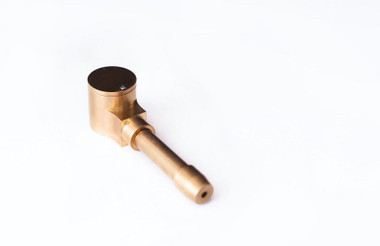There is no accounting for the history of hand pipes without first discussing their predecessor - the tobacco pipe. Maybe it’s because tobacco smoking has fallen out of favor to such an extreme degree that no one wants to touch it as a subject, but the history of tobacco pipes is still shrouded in uncertainty. No one seems to know (or care) exactly where they originated or with what culture.
What is known is that tobacco is a South American plant that eventually spread to North America and was taken to Europe by explorers during the 16th century. From there it quickly spread around the world. There are sites in Mexico where tobacco is known to have been cultivated more than 3,000 years ago. And, of course, the cultivation of tobacco implies pipes to smoke it. But there are no pipes in the Central American archeological record of that time to confirm this.
The Origin of Hand Pipes
No one is sure who came up with the idea of smoking tobacco with hand pipes. Some have suggested that the ancient Egyptians enjoyed a bowl now and then. But there is simply no evidence to confirm this. The earliest verifiable use of the handheld smoking pipe was in North America during the centuries immediately prior to the arrival of Europeans. When Europeans then brought tobacco back to England, Spain and other countries, they brought the Native American pipes with them.
Synergy
While tobacco, and tobacco use, originated in South America, cannabis, and cannabis use, can trace its origins to north-central Asia some 4,000 years ago. The cannabis plant was first used for its fibrous qualities, but somewhere along the line, someone realized there were pleasures to be had by consuming it, and also by burning it and inhaling the vapors.
As the centuries passed, cannabis spread throughout the rest of Asia and, sometime around 1,000 AD, to the Middle East and Europe. While some people still used the plant to make rope and other practical items, there was an increasing number who enjoyed its recreational qualities. However, like the ancient Chinese before them, they were still confined to either eating it or burning large quantities of it and inhaling the resulting smoke.
In the 16th century, explorers returned to Europe from North America with both tobacco and the hand pipes for smoking it. Both quickly made their way across Europe and then on to the Middle East where they were soon adopted as a means for smoking cannabis. This led to the development of pipes especially for this purpose, and it wasn’t long before weed pipes and tobacco pipes were diverging in both size and style.
From Large Tobacco Pipes to Discreet Hand Pipes
When people first began using the handheld tobacco pipe to smoke weed they realized the two practices were fundamentally different and that tobacco pipes were not the optimal delivery vector for a good buzz. Tobacco pipe bowls were (and are) quite large and, as you didn’t need all that much cannabis to produce the desired effect, using tobacco pipes was a wasteful practice. As such, some enterprising folks began to develop smaller pipes often made of clay for the purpose.
Another of the driving forces behind the design of palm-size hand pipes was the fact that marijuana use was not exactly socially acceptable at the time, even though in many places it was not actually illegal. Illegality did not raise its ugly and shortsighted head until the 19th century when the powers that be began equating cannabis with opium and moved to ban its cultivation, sale and use.
Enter the UN
In 1961 the United Nations Single Convention on Narcotic Drugs determined that cannabis use could not be justified for medical purposes, and wound up listing it twice as both a Schedule I drug that had a serious potential for abuse, and as a Schedule IV drug that was as dangerous to body and mind as heroin. Nations around the world used the UN determinations to craft their own marijuana laws.
At around the same time, cannabis use was exploding among so-called "baby boomers" which, in turn, caused a spike in the market for those discreet hand pipes that could be easily concealed in the presence of The Man. It was also around this time that glass pipes began to appear. Glass pipes upped the ante when it came to pipe design and slowly but surely began to take over the hand pipe market. Today, the best glass pipes are as much works of art as they are devices for enjoying weed.
A New Day Dawns
Over the past decade, marijuana and its derivatives have slowly begun to shed the stigma attached to them by decades, even centuries, of ignorance. State after state has either decriminalized possession or taken the extra steps of legalizing its medical and recreational use. But there is still more to be done. As of this writing, there are only 15 states where recreational cannabis use is currently legal. Meaning in most of the country you still have to keep that beautiful glass hand pipe tucked away in your inside jacket pocket.
But don’t despair. Change may take time, but change is occurring even as you read this. The future for hand pipes is bright, as is the future for those that like to use their hand pipe as a vehicle for enjoying their favorite strain of cannabis.

 US Dollar
US Dollar
